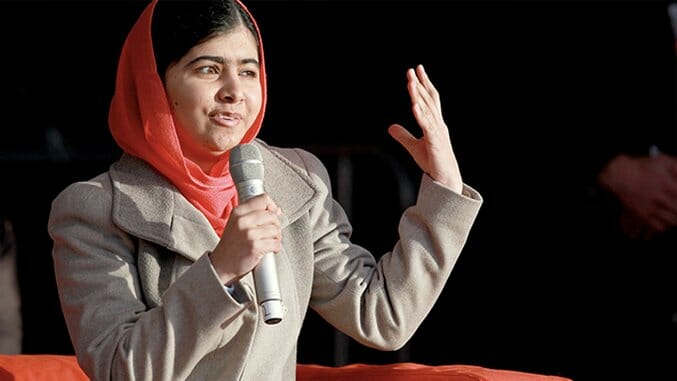He Named Me Malala

In 2012, the then-15-year-old Malala Yousafzai, a young, Pakistani education rights advocate, was on a school bus when a Taliban gunman boarded, asked for her by name and shot her in the face. She and two of her friends were wounded in the attack. They all survived, but Malala’s physical recovery wasn’t easy. Instead of deterring her activism, the assault only strengthened her resolve, and since her shooting she’s become a force to be reckoned with, meeting with international leaders and heads of state, speaking out on the right to an education for all children—especially for girls. Her courage and heroism are undeniable: For her efforts, in 2014 at age 17, Malala became the youngest winner of the Nobel Peace Prize.
Her story is one that needs to be told—but director Davis Guggenheim’s documentary, He Named Me Malala, feels, unfortunately, incomplete: His admiration, while completely understandable, too readily canonizes Malala onscreen, giving short shrift to a much more complex, fuller portrait of such a compelling person. The film begins with an audio recording of Malala in conversation with Guggenheim, recounting her namesake’s story with the help of beautiful storybook animation, hand-drawn by a host of artists, led by designer Jason Carpenter. As he’s done in previous films (It Might Get Loud and Waiting for Superman), Guggenheim employs animation for scenes too difficult to recreate, such as scenes from Malala’s old life in the once-bucolic Swat Valley of Pakistan. (Since the attack, her family’s been living in Birmingham, England, as the Taliban has vowed to kill her if she were to return.)
Malala reveals that her father, Ziauddin (Zia) Yousafzai, chose her name in honor of Malalai of Maiwand, a young Afghani heroine, who rallied local Pashtun fighters against English soldiers at the Battle of Maiwand in 1880. Malalai urged the Afghans to choose to “live like a lion for one day than a slave for 100 years,” and then was shot and killed on the battlefield—inspiring her countrymen to defeat the British in battle. It’s an eerie parallel to the young 21st-century Malala, and with this opening sequence, Guggenheim flirts with questions of fate and predestination, of whether or not Zia has unduly influenced his daughter to take up his mantle as an education activist. Only, He Named Me Malala fails to dive beneath the surface—beneath any surface—and instead spotlights her already well-documented public life through news footage and interviews.
Guggenheim has said that the close father-daughter bond is at the heart of the documentary—Zia, who’s featured prominently in the film, is clearly proud of his daughter’s courage and bravery—though the father wonders if Malala ever begrudges him for pushing her onto the political stage at such a young age. He blames himself for putting his daughter in harm’s way, but Malala, who idolizes her father, harbors no resentment—not even for the gunman who tried to kill her.
-

-

-

-

-

-

-

-

-

-

-

-

-

-

-

-

-

-

-

-

-

-

-

-

-

-

-

-

-

-

-

-

-

-

-

-

-

-

-

-








































